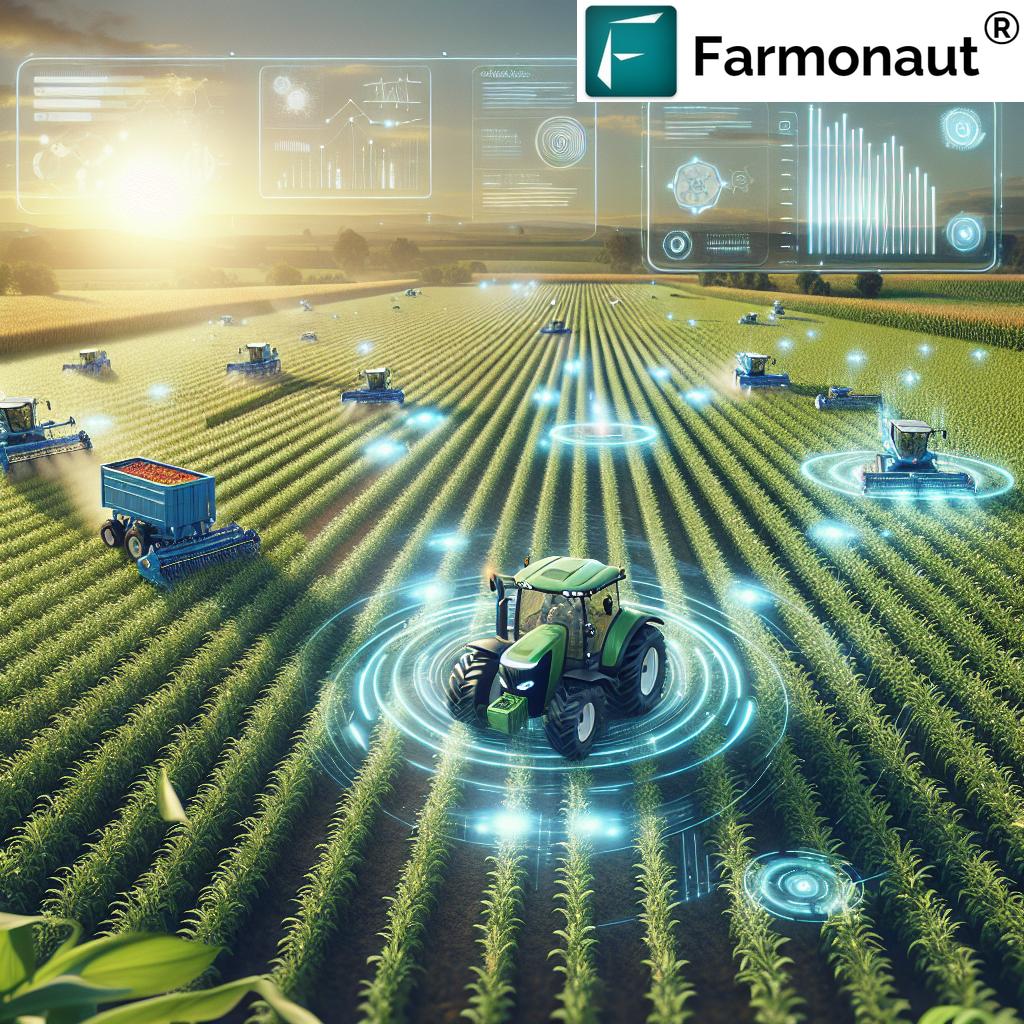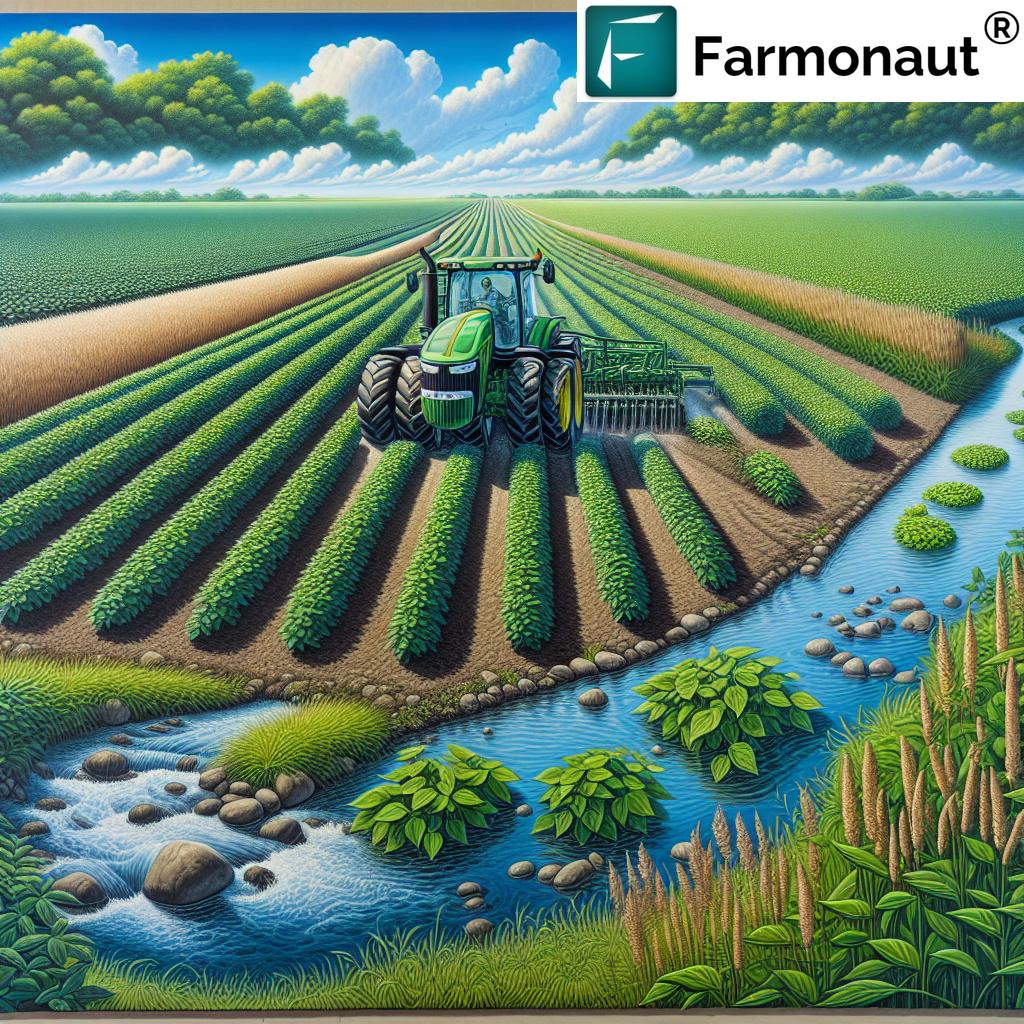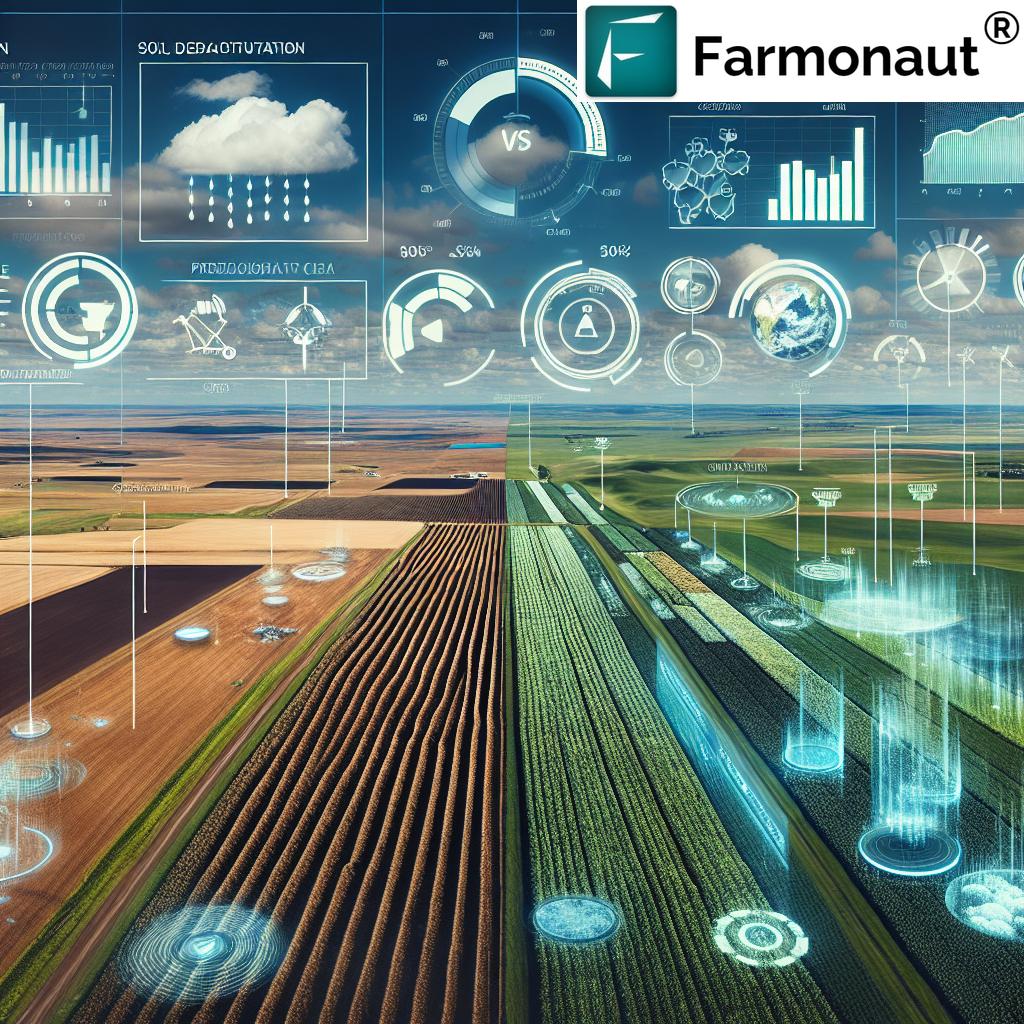Revolutionizing Agriculture: How Autonomous Farm Equipment is Boosting Productivity and Efficiency in the Americas
“The smart farming solutions market is projected to reach USD 9.86 billion by 2030, revolutionizing agriculture in the Americas.”
In the vast agricultural landscapes of the Americas, a quiet revolution is taking place. Autonomous farm equipment and precision agriculture technology are transforming the way we cultivate crops, manage resources, and feed the world. As we delve into this exciting frontier, we’ll explore how these innovations are addressing labor shortages, boosting efficiency, and shaping the future of farming.
At Farmonaut, we’re at the forefront of this agricultural revolution, offering advanced satellite-based farm management solutions that complement the rise of autonomous equipment. Our mission is to make precision agriculture accessible and affordable for farmers worldwide, integrating cutting-edge technology with traditional farming practices.
The Rise of Autonomous Farm Equipment
The agricultural industry is witnessing a significant shift towards automation, driven by the need for increased productivity and efficiency. Autonomous farm equipment, ranging from self-driving tractors to AI-powered harvesting systems, is leading this charge. These smart farming solutions are projected to reach a market value of USD 9.86 billion by 2030, indicating the rapid growth and adoption of these technologies.

Key factors driving this growth include:
- Labor shortages in the agricultural sector
- Increasing demand for food production
- The need for sustainable farming practices
- Advancements in AI and machine learning technologies
As we explore the impact of autonomous farm equipment, it’s essential to understand how these technologies work in tandem with precision agriculture solutions like those offered by Farmonaut. Our satellite-based crop health monitoring and AI advisory systems complement autonomous equipment by providing crucial data for optimized decision-making.
Types of Autonomous Farm Equipment
The agricultural automation landscape is diverse, with various types of equipment designed to handle specific tasks. Let’s explore some of the most innovative autonomous farm equipment revolutionizing the industry:
1. Autonomous Tractors
Self-driving tractors are at the forefront of the agricultural automation revolution. These intelligent vehicles can operate without human intervention, performing tasks such as plowing, seeding, and fertilizing with precision. Key features include:
- GPS guidance systems for accurate navigation
- Obstacle detection and avoidance capabilities
- Remote monitoring and control options
- Integration with farm management software
The adoption of autonomous tractors is rapidly growing, with major manufacturers like John Deere and Case IH leading the way in development and production.
2. Autonomous Harvesting Systems
Harvesting is one of the most labor-intensive and time-sensitive operations in agriculture. Autonomous harvesting systems are addressing these challenges by offering:
- Robotic arms for precise fruit and vegetable picking
- Computer vision technology for crop identification and quality assessment
- Automated sorting and packaging capabilities
- 24/7 operation potential, increasing efficiency during critical harvest periods
These systems are particularly beneficial for high-value crops like fruits and vegetables, where gentle handling and quality control are paramount.
3. Crop Monitoring Drones
Unmanned aerial vehicles (UAVs) or drones equipped with multispectral cameras and sensors are revolutionizing crop monitoring. These autonomous flying machines offer:
- Real-time data on crop health and growth
- Early detection of pest infestations and diseases
- Precise mapping of field conditions
- Efficient application of pesticides and fertilizers
At Farmonaut, we complement drone technology with our satellite-based crop health monitoring system, providing farmers with comprehensive insights into their fields’ conditions.
4. Autonomous Irrigation Systems
Water management is crucial for sustainable agriculture. Autonomous irrigation systems are helping farmers optimize water usage through:
- Soil moisture sensors for precise water application
- Weather data integration for intelligent scheduling
- Remote control and monitoring capabilities
- Integration with crop health data for optimized irrigation strategies
These systems not only conserve water but also improve crop yields by ensuring plants receive the right amount of water at the right time.
The Impact of Autonomous Farm Equipment on Agricultural Productivity
The adoption of autonomous farm equipment is having a profound impact on agricultural productivity and efficiency. Let’s examine how these technologies are transforming various aspects of farming:
| Agricultural Aspect | Traditional Farming | Autonomous Farming | Projected Improvement (%) |
|---|---|---|---|
| Labor Requirements | High reliance on manual labor | Reduced need for human operators | 50-70% reduction |
| Operational Efficiency | Limited by human factors (fatigue, errors) | 24/7 operation potential, consistent performance | 30-40% increase |
| Resource Utilization | Often imprecise, leading to waste | Optimized use of water, fertilizers, and pesticides | 20-30% reduction in inputs |
| Soil Health | Risk of over-tilling and compaction | Precise tillage and reduced soil compaction | 15-25% improvement |
| Overall Productivity | Subject to human limitations | Enhanced yields through precision and efficiency | 10-20% increase |
As we can see from this comparison, the shift towards autonomous farming practices offers significant improvements across various agricultural aspects. These advancements not only boost productivity but also contribute to more sustainable and environmentally friendly farming practices.
AI in Agriculture: The Brain Behind Autonomous Equipment
Artificial Intelligence (AI) is the driving force behind the effectiveness of autonomous farm equipment. AI algorithms process vast amounts of data from various sources, including sensors, satellites, and historical records, to make informed decisions and optimize farming operations.
Key applications of AI in agriculture include:
- Predictive analytics for crop yield forecasting
- Pest and disease detection through image recognition
- Optimal route planning for autonomous vehicles
- Real-time adjustment of equipment parameters based on field conditions
At Farmonaut, our Jeevn AI Advisory System leverages these AI capabilities to provide personalized farm management recommendations, complementing the functions of autonomous equipment.
The Rise of Electric Tractors in Agriculture
As the agricultural industry moves towards more sustainable practices, electric tractors are gaining traction. These eco-friendly vehicles offer several advantages over their diesel counterparts:
- Reduced carbon emissions and environmental impact
- Lower operating costs due to decreased fuel consumption
- Quieter operation, reducing noise pollution in rural areas
- Potential for integration with renewable energy sources on farms
Major manufacturers are investing heavily in electric tractor technology, with some models already available on the market. The shift towards electric power aligns with the broader trend of sustainable farming practices and complements the adoption of autonomous technologies.
Challenges and Opportunities in Adopting Agricultural Automation
While the benefits of autonomous farm equipment are clear, there are several challenges that farmers and manufacturers must address:
Initial Investment Costs
The high upfront costs of autonomous equipment can be a significant barrier for many farmers, especially smaller operations. However, long-term benefits often outweigh these initial expenses through:
- Reduced labor costs
- Improved efficiency and productivity
- Potential government incentives for adopting sustainable technologies
Regulatory Considerations
As autonomous equipment becomes more prevalent, regulatory frameworks must evolve to address safety concerns and liability issues. Key areas of focus include:
- Safety standards for autonomous vehicles in agricultural settings
- Data privacy and security regulations
- Insurance and liability considerations for autonomous operations
Technical Infrastructure
Reliable internet connectivity and GPS coverage are essential for the effective operation of autonomous farm equipment. Improving rural broadband infrastructure is crucial for widespread adoption.
Workforce Transition
As automation reduces the need for manual labor, there’s an opportunity to upskill agricultural workers for roles in equipment maintenance, data analysis, and precision agriculture management.
“Autonomous farm equipment addresses labor shortages and boosts efficiency, with the Americas leading in adoption of this technology.”
Regional Market Trends: The Americas Leading the Way
The Americas, particularly North America, are at the forefront of autonomous farm equipment adoption. Several factors contribute to this regional leadership:
- Large-scale farming operations that benefit from automation
- Strong technological infrastructure and research capabilities
- Supportive regulatory environment for agricultural innovation
- High labor costs driving the need for automation
As pioneers in this field, farmers and manufacturers in the Americas are setting trends that are likely to influence global agricultural practices in the coming years.

The Role of Precision Agriculture in Complementing Autonomous Equipment
Precision agriculture technologies, such as those offered by Farmonaut, play a crucial role in maximizing the benefits of autonomous farm equipment. Our satellite-based solutions provide valuable data that can be integrated with autonomous systems for optimal decision-making.
Key synergies include:
- Real-time crop health data informing autonomous equipment operations
- Precision mapping for optimized route planning and resource application
- Historical field data enhancing AI-driven decision-making processes
- Integration of weather forecasts for proactive equipment scheduling
By combining autonomous equipment with precision agriculture technologies, farmers can achieve unprecedented levels of efficiency and sustainability in their operations.
Explore Farmonaut’s precision agriculture solutions:
The Future of Autonomous Farm Equipment
As we look towards the future, several trends are likely to shape the evolution of autonomous farm equipment:
1. Increased AI Integration
Future autonomous systems will feature more advanced AI capabilities, enabling them to make complex decisions based on real-time data and long-term trends.
2. Swarm Technologies
Fleets of smaller, coordinated autonomous vehicles may replace larger, individual machines, offering greater flexibility and reduced soil compaction.
3. Enhanced Connectivity
The rollout of 5G networks in rural areas will improve communication between autonomous equipment, farm management systems, and cloud-based analytics platforms.
4. Sustainable Power Sources
Advancements in electric and hydrogen fuel cell technologies will make autonomous equipment more environmentally friendly and cost-effective to operate.
Sustainable Farming Practices Enabled by Autonomous Equipment
Autonomous farm equipment is not just about efficiency; it’s also a key driver of sustainable agriculture. These technologies enable farmers to implement environmentally friendly practices such as:
- Precision application of inputs, reducing chemical use and runoff
- Controlled traffic farming, minimizing soil compaction
- Variable rate technology for optimized resource usage
- Cover crop management for improved soil health
By integrating autonomous equipment with Farmonaut’s satellite-based monitoring and AI advisory systems, farmers can make data-driven decisions that promote long-term sustainability while maintaining high productivity.
The Economic Impact of Agricultural Automation
The adoption of autonomous farm equipment has far-reaching economic implications for the agricultural sector and beyond:
- Increased farm profitability through reduced labor costs and improved yields
- Growth in high-skilled jobs in agricultural technology and data analysis
- Development of new industries supporting autonomous equipment manufacturing and maintenance
- Potential for increased food security and reduced food prices due to improved production efficiency
As the market for autonomous farm equipment continues to grow, we can expect to see significant economic benefits across the agricultural value chain.
Farmonaut’s Role in the Autonomous Agriculture Revolution
At Farmonaut, we’re committed to supporting the adoption of autonomous farm equipment through our advanced satellite-based solutions. Our technologies complement autonomous systems by providing:
- Real-time crop health monitoring for informed decision-making
- AI-powered advisory services for optimized farm management
- Blockchain-based traceability solutions for supply chain transparency
- Carbon footprinting tools to support sustainable farming practices
By leveraging our platform, farmers can maximize the benefits of their autonomous equipment investments and drive towards more efficient, sustainable, and profitable operations.
Explore our API for seamless integration with your autonomous systems: Farmonaut API
For developers looking to integrate our solutions: API Developer Docs
Conclusion: Embracing the Future of Agriculture
The rise of autonomous farm equipment represents a pivotal moment in agricultural history. As we’ve explored, these technologies are not just improving efficiency and productivity; they’re reshaping the very nature of farming. From addressing labor shortages to promoting sustainable practices, autonomous equipment is paving the way for a more resilient and productive agricultural sector.
As we look to the future, the integration of autonomous equipment with precision agriculture technologies like those offered by Farmonaut will be key to unlocking the full potential of these innovations. By embracing these advancements, farmers in the Americas and beyond can position themselves at the forefront of a new agricultural era – one that is more efficient, sustainable, and capable of meeting the growing global demand for food.
The journey towards fully autonomous farming is ongoing, and challenges remain. However, with continued investment, research, and collaboration between technology providers, equipment manufacturers, and farmers, we are confident that the agricultural industry will overcome these hurdles and reap the immense benefits of automation.
At Farmonaut, we’re excited to be part of this revolution, providing the data-driven insights and AI-powered recommendations that will help farmers make the most of their autonomous equipment investments. Together, we can build a future where agriculture is not only more productive but also more sustainable and in harmony with our planet’s resources.
FAQs
- Q: How does autonomous farm equipment impact job opportunities in agriculture?
A: While autonomous equipment may reduce the need for certain manual labor roles, it creates new opportunities in areas such as equipment maintenance, data analysis, and precision agriculture management. - Q: Are autonomous farm machines safe to operate?
A: Autonomous farm equipment is designed with multiple safety features, including obstacle detection and emergency stop mechanisms. As the technology advances, safety protocols continue to improve. - Q: How can small-scale farmers benefit from agricultural automation?
A: Small-scale farmers can benefit through improved efficiency, reduced labor costs, and access to precision agriculture techniques. Solutions like Farmonaut’s satellite-based monitoring make advanced technologies more accessible and affordable for smaller operations. - Q: What role does GPS play in autonomous farm equipment?
A: GPS is crucial for guiding autonomous equipment, enabling precise navigation, and facilitating accurate application of inputs. It’s a key component in achieving the high levels of precision required for efficient autonomous operations. - Q: How does autonomous equipment contribute to sustainable farming practices?
A: Autonomous equipment contributes to sustainability by optimizing resource use, reducing chemical inputs through precision application, minimizing soil compaction, and enabling more efficient energy use in farming operations.



















